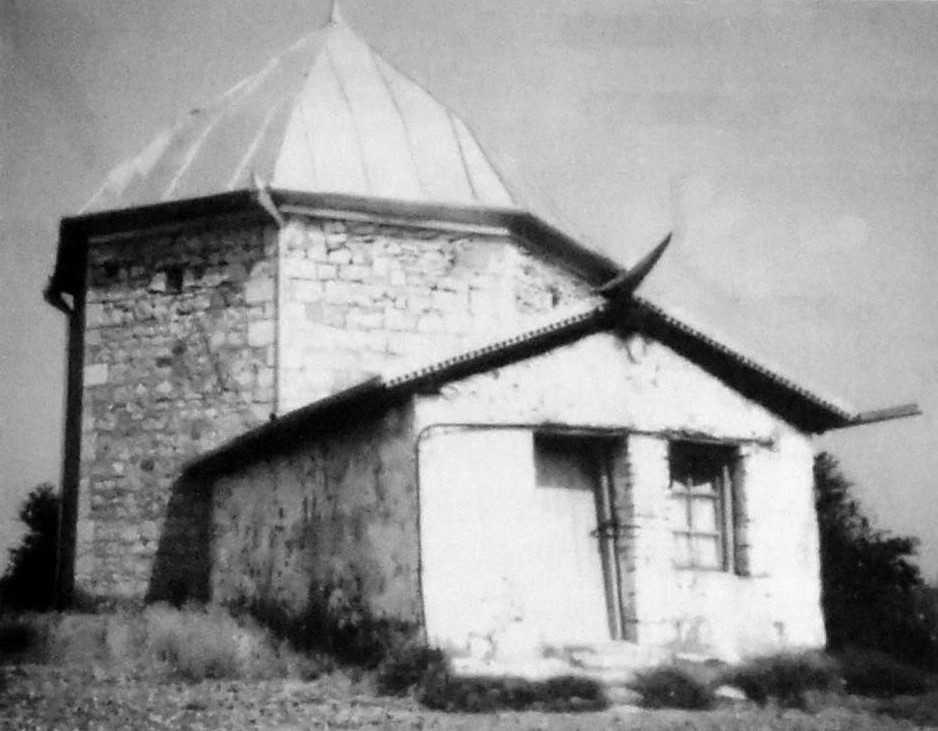The mausoleum of Sheikh İbrahim is located in the cemetery of the village of Ashagy Aybasanly in Fuzuli district of Azerbaijan. Among the local residents, the monument is known as the “Tomb of Iba” or “Mausoleum of Iba İbrahim”.
[Karabakh: history in the context of the conflict\\Meshadi khanum Neymatova. Epigraphic monuments of Karabakh. 2014, p. 138]
[R. Karabaghly. From Karabulak to Fuzuli. 2004, p. 86]
[R. Karabaghly. Architectural monuments of Fuzuli district. 2017, p. 68]

The mausoleum was built in 1632-1633. This is confirmed by a half-erased two-line Arabic inscription engraved in the left corner of the door opening of the monument:
“Greetings to them, mercy and blessings of Allah, Ibrahim son of Musa al-Kazim, greetings to him, Avazali son of Alimardan sons of D-M-G-L-I, who lives near the tomb of the saint in 1042nd year of Hijri (1632\1633).” Probably Avazali, whose name was indicated in the inscription, was the master who built the mausoleum.
[R. Karabaghly. Architectural monuments of Fuzuli district. 2017, p. 68]
[Karabakh: history in the context of the conflict\\Meshadi khanum Neymatova. Epigraphic monuments of Karabakh. 2014, p. 138]
Presumably at the beginning of the XX century, the current mausoleum was rebuilt on the foundation of the destroyed mausoleum by local residents.
In 1980 a local resident Usub from the village of Kurdlar noted:
“When I was little, I was told that the mausoleum of Iba Ibrahim had collapsed. At that time, at the initiative of Meshadi Imamverdi, many stones were extracted from Ilanli Mountain, then they were taken to the mausoleum on 20 bullock carts and were used in construction of the mausoleum.”
Another confirmation that the mausoleum was rebuilt are the memorial monuments located in the cemetery.
[R. Karabaghly. Architectural monuments of Fuzuli district. 2017, p. 70]
[Karabakh: history in the context of the conflict\\Meshadi khanum Neymatova. Epigraphic monuments of Karabakh. 2014, p. 139]
The plan of the mausoleum is octagonal from the outside, and the inner wall has a smooth round shape plastered with lime mortar. The mausoleum was built of lime stone, and its dome is made of baked brick. The interior of the mausoleum is dimly illuminated from five sides by small windows located closer to its dome.
[Karabakh: history in the context of the conflict\\Meshadi khanum Neymatova. Epigraphic monuments of Karabakh. 2014, p. 138]
[R. Karabaghly. Architectural monuments of Fuzuli district. 2017, p. 70]
The entrance to the mausoleum is located on the east and ends with a pointed arch. The height of the doorway is 1.5 m, and the width is 0.73 m. In the upper left corner of the doorway of the mausoleum there was carved a woman standing under a tree and next to her was depicted a horse.
[R. Karabaghly. Architectural monuments of Fuzuli district. 2017, p. 68]
[Karabakh: history in the context of the conflict\\Meshadi khanum Neymatova. Epigraphic monuments of Karabakh. 2014, p. 138]
There is a grave in the center of the mausoleum. Stones are placed on the side of the buried person’s head and feet. There is an Arabic inscription on the first stone: “Hussein Karkazi wrote it (inscription). In the name of the gracious, merciful God. Allah, Muhammad, Ali, Fatima, Hassan, Hussein… Al Muzaffar… Repair of this sacred grave… bey son of the late Mohammed bey son of Sharif bey.” (1302 H. – 1884\1885)
Azerbaijani architect Rizvan Karabaghly noted that there is no inscription in the mausoleum that indicates the name of Sheikh Ibrahim. He points out that, undoubtedly, some of the inscriptions for unknown reasons remained on another part of the broken stone. In his opinion, the date 1302 (1884-1885) (inscription on the grave in the center of the mausoleum) could not be the date of the sheikh’s death since it does not correspond to the date of construction of the mausoleum (1632-1633). Karabagly wrote the following: “According to local elderly residents, when the mausoleum collapsed, the sheikh’s grave was also destroyed. (However, in R.Karabaghly’s book “From Karabulak to Fuzuli” (2004), it is noted that according to local residents, the mausoleum and grave were destroyed after the Sovietization of Azerbaijan). Based on this, it can be said that the stone with inscription that placed here during the restoration of the mausoleum and the grave was taken by mistake from another grave. The fact that the stone was placed upside down on the lower side of the grave once again confirms this idea.”
[R. Karabaghly. Architectural monuments of Fuzuli district. 2017, pp. 70-71]
[Karabakh: history in the context of the conflict\\Meshadi khanum Neymatova. Epigraphic monuments of Karabakh. 2014, p. 139]
[R. Karabaghly. From Karabulak to Fuzuli. 2004, p. 89]
On the second stone there is an inscription in Azerbaijani: “The occupant of this tomb is the venerable grandson of His Excellency Imam Musa Kazim… Karbalai Mirza Ali. 1325 of H.” (1907\1908).
Arabic inscription on the third stone: “Greeting of God. In the name of the gracious, merciful God. Thank God, bless His messenger… and come in. Oh, God! Oh, the fourteen immaculate ones and the mercy of God and His blessing.) Mirza Haydar Karkazi wrote it (inscription)”. The handwriting of the inscription refers to the XIX – early XX century.
[Karabakh: history in the context of the conflict\\Meshadi khanum Neymatova. Epigraphic monuments of Karabakh. 2014, p. 139]
In the book of the Azerbaijani architect R. Karabaghly “Architectural monuments of Fuzuli district” (2017), the following is noted:
“However, at the beginning of the XX century, the center of the dome, which was subjected to natural and artificial destruction, collapsed. Later, with the help of local residents, the upper part of the tomb was again covered with a reinforced concrete dome, without touching the dilapidated dome itself. (This is clearly visible from the ceiling of the mausoleum’s interior). However, since this coating did not retain natural water, it was coated on the outside with a layer of stainless non-ferrous white metal. The metal coating does not let natural water into the center of the tomb, but completely modernizes the monument, spoiling its architecture and former appearance.”
[R. Karabaghly. Architectural monuments of Fuzuli district. 2017, p. 68]
In the 1980s and early 1990s, a small corridor was built on the side of the entrance door of the mausoleum. This structure was intended for visitors to take off their shoes before entering the mausoleum. According to R. Karabaghly, this structure also did not correspond to the architecture of the monument.
[R. Karabaghly. Architectural monuments of Fuzuli district. 2017, p. 71]
With the occupation of Fuzuli by Armenian armed groups in 1993, the mausoleum was vandalized. The outer metal covering and the corridor adjacent to the mausoleum were destroyed.




